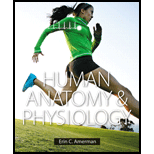
Human Anatomy & Physiology
1st Edition
ISBN: 9780805382952
Author: Erin C. Amerman
Publisher: PEARSON
expand_more
expand_more
format_list_bulleted
Textbook Question
Chapter 5, Problem 14CYR
Nail growth occurs when:
a. cells in the nail plate undergo mitosis.
b. cells in the nail matrix undergo mitosis.
c. cells in the eponychium undergo mitosis.
d. cells in the medial and lateral nail folds undergo mitosis.
Expert Solution & Answer
Want to see the full answer?
Check out a sample textbook solution
Students have asked these similar questions
What is the difference between Uniporters, Symporters and Antiporters? Which of these are examples of active transport?
What are coupled transporters?
What are “domains” and how do they aid in protein function?
Chapter 5 Solutions
Human Anatomy & Physiology
Ch. 5.1 - 1. What are the major structures of the skin, and...Ch. 5.1 - Explain how the integument provides protection...Ch. 5.1 - Prob. 3QCCh. 5.1 - Describe the other functions of the integument....Ch. 5.2 - 1. What are the five strata of the epidermis? How...Ch. 5.2 - Explain how a keratinocyte that begins its life in...Ch. 5.2 - In addition to keratinocytes, what three types of...Ch. 5.2 - Compare and contrast thin and thick skin.Ch. 5.3 - Which type of tissue makes up the papillary layer...Ch. 5.3 - What are the functions of the dermal papillae?
Ch. 5.3 - 3. Which type of tissue makes up the reticular...Ch. 5.3 - 4. What other structures are located in the...Ch. 5.3 - 5. How does the papillary layer of the dermis...Ch. 5.3 - What causes tension lines and flexure lines? How...Ch. 5.4 - How is melanin produced, and how does it interact...Ch. 5.4 - What are the functions of melanin?Ch. 5.4 - 3. What is carotene, and what color does it give...Ch. 5.4 - Prob. 4QCCh. 5.4 - 5. How can the oxygen content of the blood affect...Ch. 5.4 - 6. What is cyanosis, and what can it tell us...Ch. 5.5 - How do the hair shaft and hair root differ?Ch. 5.5 - How does a hair grow in length?Ch. 5.5 - Prob. 3QCCh. 5.5 - Define the following terms: nail bed, nail plate,...Ch. 5.5 - How does nail growth occur?Ch. 5.5 - Prob. 6QCCh. 5.5 - What are the other three types of sweat glands,...Ch. 5.5 - 8. How do sebaceous glands and sebum differ from...Ch. 5.6 - Prob. 1QCCh. 5.6 - Prob. 2QCCh. 5.6 - What is cancer?Ch. 5.6 - 4. How do the three types of skin cancer differ?
Ch. 5 - Explain why the skin is an organ.Ch. 5 - Which of the following correctly describes the...Ch. 5 - Which of the following is not a function of the...Ch. 5 - 4. Explain what happens to dermal blood vessels...Ch. 5 - Number the strata of thick skin epidermis from...Ch. 5 - Keratinocytes in the superficial strata of the...Ch. 5 - Mark the following statements as true or false. If...Ch. 5 - Which of the following statements is false? a....Ch. 5 - What are the functions of the dermal papillae?Ch. 5 - Epidermal ridges are created by: a. the epidermal...Ch. 5 - 11. Mark the following statements as true or...Ch. 5 - 12. Which of the following is not a function of...Ch. 5 - 13. Fill in the blanks: The portion of the hair...Ch. 5 - Nail growth occurs when: a. cells in the nail...Ch. 5 - Prob. 15CYRCh. 5 - Match each type of gland with its correct...Ch. 5 - How do sweat and sebum differ?Ch. 5 - 18. Which type of burn involves the epidermis and...Ch. 5 - 19. The type of skin tumor that involves the...Ch. 5 - Prob. 1CYUCh. 5 - Prob. 2CYUCh. 5 - The hair and nails are sometimes called accessory...Ch. 5 - 1. You are working in the emergency department...Ch. 5 - 2. After Ramon’s skin came into contact with a...Ch. 5 - 3. Which of the following is not a function of...Ch. 5 - 4. What would happen to the skin if the oil...Ch. 5 - Many antiaging skin creams contain collagen and...Ch. 5 - 6. Would a mild second-degree burn be likely to...
Knowledge Booster
Learn more about
Need a deep-dive on the concept behind this application? Look no further. Learn more about this topic, biology and related others by exploring similar questions and additional content below.Similar questions
- What are intrinsically disordered proteins, and how might they be useful for a living system?arrow_forwardWhat are Amyloid Fibrils? What biological functions are these known to perform?arrow_forwardHow do histamine and prostaglandins help in the mobilization of leukocytes to an injury site? What are chemotactic factors? How do they affect inflammation process?arrow_forward
- Compare and contrast neutrophils and macrophages. Describe two ways they are different and two ways they are similar.arrow_forwardDescribe the effects of three cytokines (not involved in the initial inflammation response). What cells release them?arrow_forwardDescribe activation of helper T cells or cytotoxic T cellsarrow_forward
- Compare and contrast MHC 1 and MHC 2. Describe two way they are different and two ways they similar including how they are used in antigen presentation.arrow_forwardDescribe two antimicrobial properties of the skin.arrow_forwardDescribe how the inflammation response starts including the sentinel cells and the chemicals involved. How do pathogens trigger the response particularly in the skin?arrow_forward
- How does complement promote the immune response? Describe three waysarrow_forwardWhich of the following is not a possible mechanism for autoimmunity? Select one: A. Abnormal expression of MHC II molecules in non-antigen-presenting cells B. Activation of polyclonal B cells C. Polymorphism of HLA alleles D. Molecular mimicry E. Release of sequestered antigensarrow_forwardWRITTEN WORK 3: NON-MENDELIAN GENETICS Part A: Complete the Punnett square and calculate for the probability of genotype and phenotype. i i Genotype: Phenotype: 08:55arrow_forward
arrow_back_ios
SEE MORE QUESTIONS
arrow_forward_ios
Recommended textbooks for you


The Integumentary System, Part 1 - Skin Deep: Crash Course Anatomy & Physiology #6; Author: CrashCourse;https://www.youtube.com/watch?v=Orumw-PyNjw;License: Standard youtube license